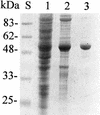Redox regulation of Arabidopsis 3-deoxy-D-arabino-heptulosonate 7-phosphate synthase
- PMID: 12177500
- PMCID: PMC166775
- DOI: 10.1104/pp.002626
Redox regulation of Arabidopsis 3-deoxy-D-arabino-heptulosonate 7-phosphate synthase
Abstract
The cDNA for 3-deoxy-D-arabino-heptulosonate 7-phosphate synthase of Arabidopsis encodes a polypeptide with an amino-terminal signal sequence for plastid import. A cDNA fragment encoding the processed form of the enzyme was expressed in Escherichia coli. The resulting protein was purified to electrophoretic homogeneity. The enzyme requires Mn(2+) and reduced thioredoxin (TRX) for activity. Spinach (Spinacia oleracea) TRX f has an apparent dissociation constant for the enzyme of about 0.2 microM. The corresponding constant for TRX m is orders of magnitude higher. In the absence of TRX, dithiothreitol partially activates the enzyme. Upon alkylation of the enzyme with iodoacetamide, the dependence on a reducing agent is lost. These results indicate that the first enzyme in the shikimate pathway of Arabidopsis appears to be regulated by the ferredoxin/TRX redox control of the chloroplast.
Figures





Similar articles
-
Expression of a bacterial feedback-insensitive 3-deoxy-D-arabino-heptulosonate 7-phosphate synthase of the shikimate pathway in Arabidopsis elucidates potential metabolic bottlenecks between primary and secondary metabolism.New Phytol. 2012 Apr;194(2):430-439. doi: 10.1111/j.1469-8137.2012.04052.x. Epub 2012 Feb 1. New Phytol. 2012. PMID: 22296303
-
Metal-catalyzed oxidation of phenylalanine-sensitive 3-deoxy-D-arabino-heptulosonate-7-phosphate synthase from Escherichia coli: inactivation and destabilization by oxidation of active-site cysteines.J Bacteriol. 1999 Mar;181(5):1636-42. doi: 10.1128/JB.181.5.1636-1642.1999. J Bacteriol. 1999. PMID: 10049398 Free PMC article.
-
Tomato fruits expressing a bacterial feedback-insensitive 3-deoxy-D-arabino-heptulosonate 7-phosphate synthase of the shikimate pathway possess enhanced levels of multiple specialized metabolites and upgraded aroma.J Exp Bot. 2013 Nov;64(14):4441-52. doi: 10.1093/jxb/ert250. Epub 2013 Sep 4. J Exp Bot. 2013. PMID: 24006429 Free PMC article.
-
The shikimate pathway as an entry to aromatic secondary metabolism.Plant Physiol. 1995 Jan;107(1):7-12. doi: 10.1104/pp.107.1.7. Plant Physiol. 1995. PMID: 7870841 Free PMC article. Review. No abstract available.
-
Unique biosynthesis of dehydroquinic acid?Bioorg Chem. 2004 Oct;32(5):309-15. doi: 10.1016/j.bioorg.2004.06.003. Bioorg Chem. 2004. PMID: 15381397 Review.
Cited by
-
The chloroplastic thiol reducing systems: dual functions in the regulation of carbohydrate metabolism and regeneration of antioxidant enzymes, emphasis on the poplar redoxin equipment.Photosynth Res. 2010 Apr;104(1):75-99. doi: 10.1007/s11120-009-9501-8. Epub 2009 Nov 10. Photosynth Res. 2010. PMID: 19902380 Review.
-
Temporal gene expression profiling of the wheat leaf rust pathosystem using cDNA microarray reveals differences in compatible and incompatible defence pathways.Int J Plant Genomics. 2007;2007:17542. doi: 10.1155/2007/17542. Int J Plant Genomics. 2007. PMID: 18288238 Free PMC article.
-
Genetic dissection of vitamin E biosynthesis in tomato.J Exp Bot. 2011 Jul;62(11):3781-98. doi: 10.1093/jxb/err055. Epub 2011 Apr 28. J Exp Bot. 2011. PMID: 21527625 Free PMC article.
-
Characterization of a recombinant type II 3-deoxy-D-arabino-heptulosonate-7-phosphate synthase from Helicobacter pylori.Biochem J. 2005 Aug 15;390(Pt 1):223-30. doi: 10.1042/BJ20050259. Biochem J. 2005. PMID: 15853768 Free PMC article.
-
Evolution of aromatic amino acid metabolism in plants: a key driving force behind plant chemical diversity in aromatic natural products.Philos Trans R Soc Lond B Biol Sci. 2024 Nov 18;379(1914):20230352. doi: 10.1098/rstb.2023.0352. Epub 2024 Sep 30. Philos Trans R Soc Lond B Biol Sci. 2024. PMID: 39343022 Free PMC article. Review.
References
-
- Aguilar F, Brunner B, Gardet-Salvi L, Stutz E, Schürmann P. Biosynthesis of active spinach-chloroplast thioredoxin f in transformed E. coli. Plant Mol Biol. 1992;20:301–306. - PubMed
-
- Ausubel FM, Brent R, Kingston RE, Moore DD, Siedman JG, Smith JA, Struhl K. Current protocols in molecular biology. New York, NY: Green Publishing Associates and Wiley-Interscience; 1987.
-
- Bischoff M, Rösler J, Raesecke HR, Görlach J, Amrhein N, Schmid J. Cloning of a cDNA encoding 3-dehydroquinate synthase from a higher plant, and analysis of the organ-specific and elicitor-induced expression of the corresponding gene. Plant Mol Biol. 1996;31:69–76. - PubMed
-
- Bradford MM. A rapid and sensitive method for the quantitation of microgram quantities of protein utilizing the principle of protein-dye binding. Anal Biochem. 1976;72:248–254. - PubMed
MeSH terms
Substances
LinkOut - more resources
Full Text Sources
Molecular Biology Databases

